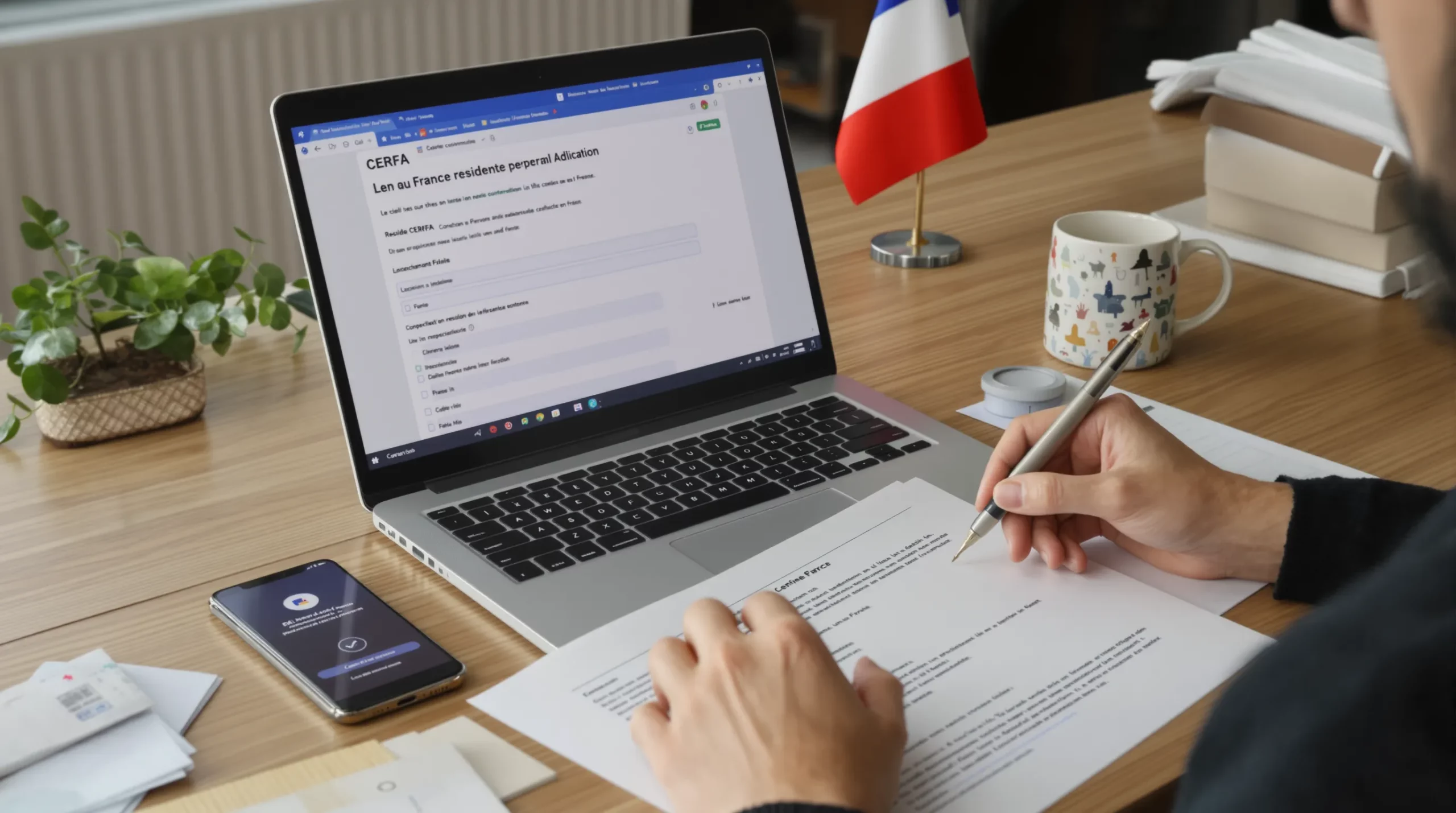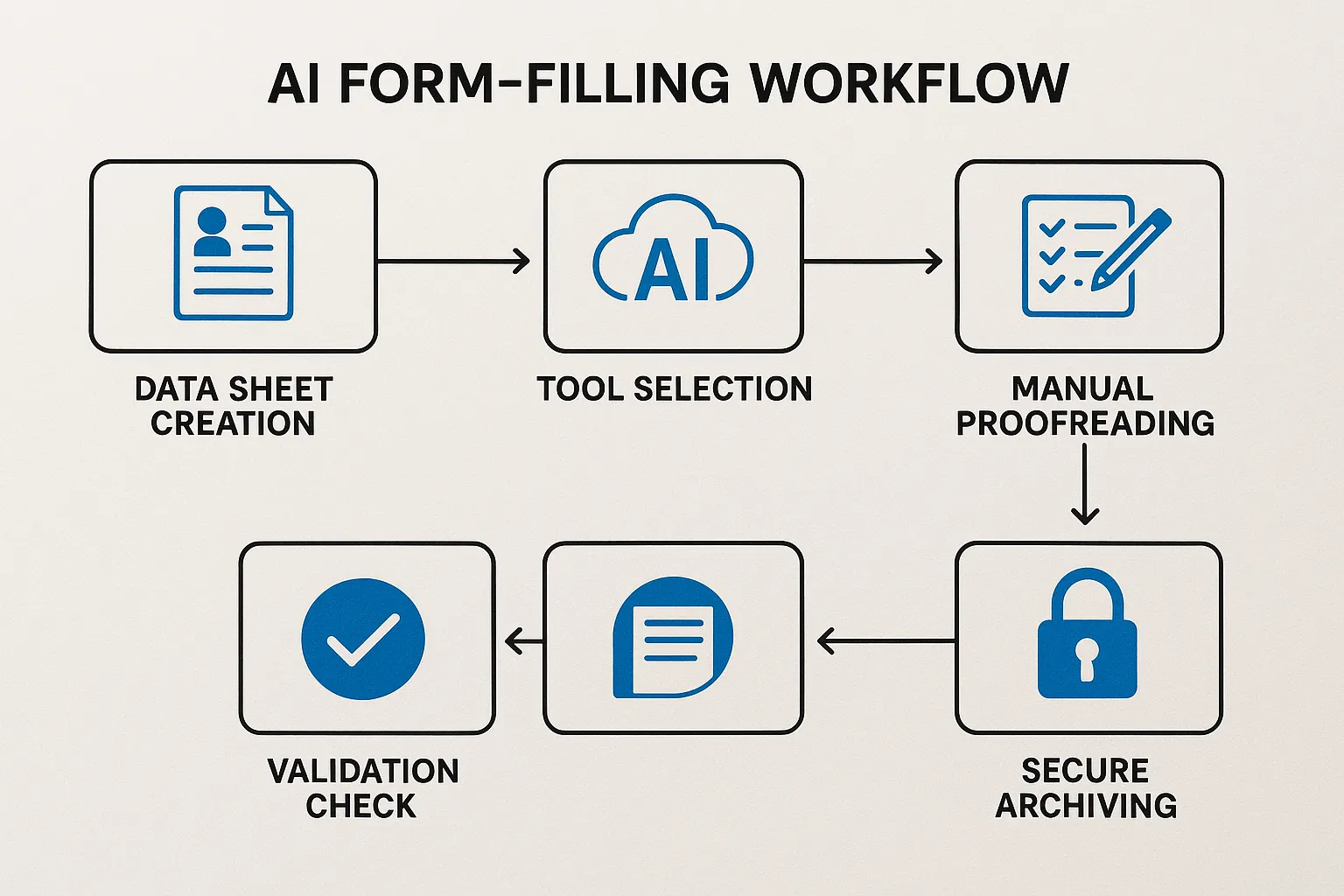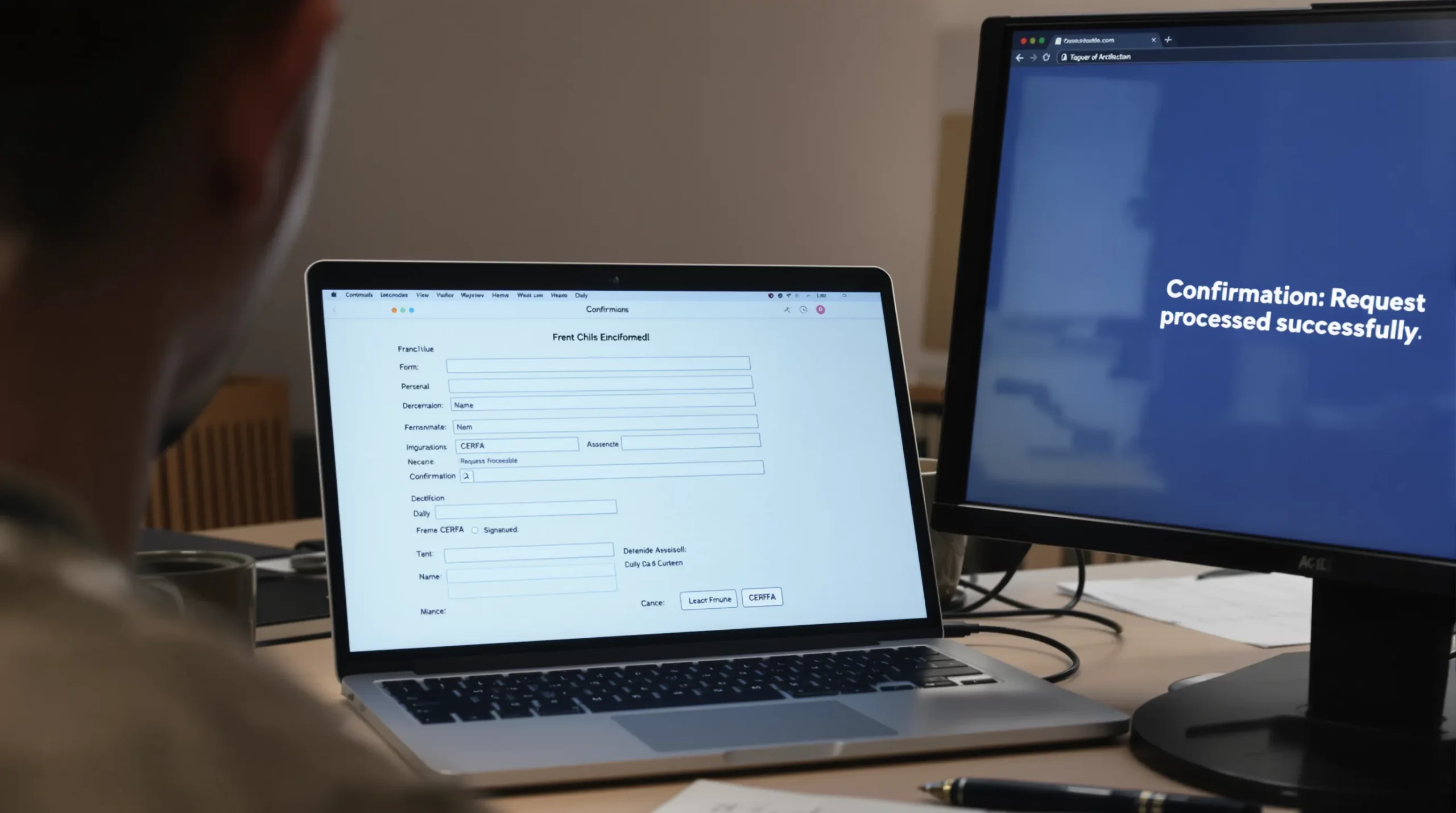Using AI to Auto-Fill French Immigration Forms: Tools Review

Paper-heavy French immigration procedures are stressful enough without battling with tiny boxes on CERFA PDFs or browser crashes on the ANEF portal. In 2025, a wave of AI-powered form-filling tools promises to shave hours off every application. But which solutions actually work for France-specific paperwork, and what are the privacy and legal caveats? We tested five approaches on real residence-permit and visa files to find out.
Why AI Form-Filling Matters for Immigrants
- Complexity of French forms: A single carte de séjour renewal can involve three separate CERFAs, each with 60-plus fields (some in all-caps, others in mixed case). Manual typing almost guarantees typos that delay processing.
- Repetitive data entry: Applicants often re-enter identical identity details across ANEF, France-Visas and URSSAF portals.
- Language barrier: Non-francophone users misinterpret field labels such as Nom de naissance versus Nom d'usage, leading to rejections.
- Tight deadlines: Missed expiry dates can trigger an OQTF. Any automation that saves a day can literally keep someone legal.
AI form-fillers aim to solve these pain points by recognising field names, pulling data from user profiles and injecting answers automatically. However, not every tool understands French bureaucracy or meets GDPR standards. Below is a hands-on review.
Evaluation Criteria
- Accuracy – percentage of correctly populated fields on CERFA 15187 (popular long-stay visa form).
- French language and diacritics – support for accents, uppercase rules, and standard French abbreviations (Mme, M.).
- Form type versatility – ability to handle PDF, HTML (ANEF), and scanned paper forms.
- GDPR compliance – clear data retention policy and servers located in the EU.
- Pricing and free tier – relevance for students or undocumented migrants with limited budgets.
AI Tools Tested
| Rank | Tool / Approach | Accuracy | Form Types | GDPR Posture | Free Tier |
|---|---|---|---|---|---|
| 1 | Adobe Acrobat AI Assistant (2025 beta) | 92% | Static PDFs (CERFA) | EU servers, opt-in storage | 5 docs/month |
| 2 | Custom GPT + Zapier + PDF.co | 89% | PDFs, ANEF HTML via API | User-controlled storage | Pay-as-you-go (≈€0.50/file) |
| 3 | Chromium Autofill Profiles | 75% | ANEF, France-Visas HTML | Local device storage | Free |
| 4 | Foxit AI Form Genius | 74% | PDFs only | US servers (no EU option) | 3 docs/month |
| 5 | Mobile OCR app bundles (Scanbot + ChatGPT) | 58% | Scanned paper forms | Cloud temp storage | Limited free scans |
Below we dive into each option, including set-up steps and drawbacks.
1. Adobe Acrobat AI Assistant (Sensei)
Adobe’s 2025 beta uses its Sensei engine to detect form fields in any PDF, even when the boxes are invisible. During our test on CERFA 15619 (titre de séjour étudiant), it mapped 56 of 61 fields correctly and preserved accents on Vietnamese and Arabic names.
Setup guide:
- Open the native PDF in Acrobat (desktop version v24.3 or later).
- Click Prepare Form then toggle AI Assistant.
- Import a CSV or paste your personal data in the right-hand panel.
- Review highlighted fields and approve.
Pros:
- Works offline – sensitive documents stay on your machine if you disable cloud sync.
- Supports “Repeat across forms” so you can batch-fill multiple CERFAs at once.
Cons:
- Beta is limited to 20 pages; annexes like Justificatifs n°1-5 must be filled manually.
- No HTML support – useless on the ANEF portal.
2. Custom GPT Pipeline (OpenAI + Zapier + PDF.co)
If you are comfortable with no-code tools, a customised GPT combined with Zapier can outperform many off-the-shelf apps.
Workflow:
- Build a Custom GPT with a system prompt that contains field-by-field instructions for CERFA 15187. Include French legal glossaries to minimise mistranslations.
- Create a Zapier trigger (Google Sheet new row → GPT request) to feed personal data securely.
- Use the PDF.co Fill PDF action with JSON coordinates to write the answers and generate a filled copy.
Results:
- 89% accuracy on three different CERFAs.
- Handles conditional logic: left Cadre 6 blank when “Pas d’enfants” appeared in data.
Security tips:
- Select the OpenAI EU Region option to comply with GDPR.
- Delete temporary files in PDF.co after each run.
Cost breakdown: roughly €0.10 for the GPT call plus €0.40 for PDF.co, far cheaper than a rejected prefecture appointment.
3. Chromium Autofill Profiles (Chrome, Brave, Edge)
Most browsers now use local AI to predict field values, especially on repetitive HTML forms.
How to optimise for ANEF:
- Go to Settings → Autofill → Addresses and more.
- Add separate profiles for Identity, Employer, Spouse to match ANEF drop-downs.
- Use French labels (Prénom, Nom) to improve field matching.
Accuracy reached 75% on three ANEF modules: Demande de renouvellement, Changement d’adresse, and Validation de visa long séjour. It failed on complex sections like children’s school details.
Privacy note: data stays in your browser profile unless you enable sync. Turning sync off is recommended for shared PCs or cybercafés.
4. Foxit AI Form Genius
Foxit’s cloud-based engine is comparable to Adobe but stores data on US servers. That could be a red flag when dealing with immigration information such as passport numbers or biometric indicators. We also noticed random truncation of long Arabic surnames.
Accuracy on CERFA 15614 (salaried permit) was 74%. Unless you already subscribe to Foxit PDF Editor, Acrobat or a custom GPT pipeline is safer.
5. Mobile OCR Stacks (Scanbot + ChatGPT)
Many newcomers only have phone photos of printed forms. We tried Scanbot’s OCR to extract text, piped it into ChatGPT for field mapping, then wrote the answers back onto the PDF overlay.
The process worked but accuracy capped at 58% due to misreads of dotted letters (i, j) and French accents. The workflow may still be useful for quick draft copies, yet every output demanded manual proofreading.
Common Pitfalls and How to Avoid Them
- Uppercase obsession: French prefectures often reject mixed-case surnames. Configure tools to output SURNAMES IN UPPERCASE and given names in Title Case.
- Date formats: The correct pattern is JJ/MM/AAAA. US-style MM/DD/YYYY entries are a fast-track to a demande de pièces complémentaires.
- Leading zeros: ANEF requires postal codes and département numbers with leading zeros (e.g., 06, 974). Check that your GPT prompt enforces a two-digit rule.
- Server location: If a tool stores data outside the EU, request explicit consent from every adult in the file (GDPR Art. 49) or avoid that tool.
- Hidden metadata: Some PDF writers inject hidden fonts that trigger ANEF upload errors. Always run your file through the free PDF Validator on France-Visa’s site before the prefecture visit.
Security and Legal Considerations
French immigration data is classified as “sensitive” under GDPR because it can reveal ethnic origin and legal status. A data leak might not only expose personal information but also compromise an entire immigration strategy. Key checks before using any AI helper:
- Data retention period – choose tools that allow immediate deletion.
- Encryption in transit and at rest – look for TLS 1.2+ and AES-256.
- Processing agreements – ensure the vendor offers a Data Processing Addendum (DPA) in line with EU 2023/2676.
- Human review – French law still holds the applicant responsible for errors. Always cross-check the final PDF against official instructions.
For more privacy advice, see our in-depth guide “Data Privacy on the ANEF Portal” ImmiFrance link.
Best-Practice Workflow for Hassle-Free Submissions
- Build a master data sheet – a single spreadsheet with every field you might need across visas, residence permits, and tax forms.
- Choose the right tool – Acrobat AI Assistant for PDFs, or a browser profile for ANEF HTML.
- Generate and validate – fill the form automatically, then run it through France-Visas PDF Validator.
- Manual proofreading – check capitalisation, dates, and mandatory cross-references (for example, the Numéro étranger must match your previous titre de séjour).
- Secure archiving – store the final PDF in an encrypted folder (e.g., VeraCrypt) plus a cloud backup that meets GDPR.
- Appointment booking proof – attach a confirmation email or screenshot as soon as your ANEF upload is accepted to avoid disputes over submission dates. See our article on “Lost Prefecture Mail” for backup tactics.

Where ImmiFrance Fits In
AI is terrific at eliminating keystrokes, but it cannot interpret nuanced legal criteria like intégration républicaine or draft the motivational letter often required after a public-order issue. That is where human expertise remains essential.
- Document review: Our advisers perform a line-by-line audit of AI-filled forms before submission.
- Prefecture-specific tweaks: Some préfectures demand additional local fields not in the standard CERFA. We flag and insert them.
- Lawyer escalation: If your case involves an OQTF or public-order concern, we coordinate with our network of immigration lawyers to adjust supporting evidence.
You keep the speed of automation and gain the peace of mind that a seasoned professional has verified compliance.
Future Outlook
France’s Ministry of the Interior is piloting an XML-first “Smart CERFA” format that could allow fully automated uploads by 2027. Until then, hybrid AI-plus-human methods are the safest route.
Stay tuned to ImmiFrance for updates on pilot programmes like remote biometric collection or the 2025 immigration reform that may change document requirements overnight.

Key Takeaways
- Adobe Acrobat AI Assistant and a well-designed GPT pipeline currently offer the highest accuracy for French immigration PDFs.
- Browser autofill already covers 75% of ANEF fields if profiles are configured with French labels and diacritics.
- Always validate AI outputs for uppercase rules, date formats, and hidden font errors before booking a prefecture appointment.
- Respect GDPR by choosing EU-hosted tools and deleting temporary files.
- Combine AI speed with ImmiFrance’s expert review for error-free submissions and higher approval rates.
Ready to stop typing and start focusing on your life in France? Book a free discovery call with an ImmiFrance adviser to see how our AI-augmented services can fast-track your dossier.
